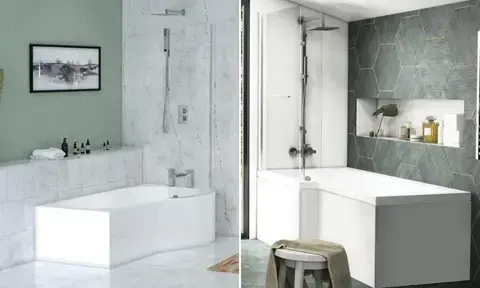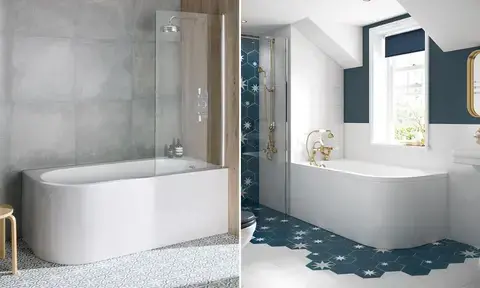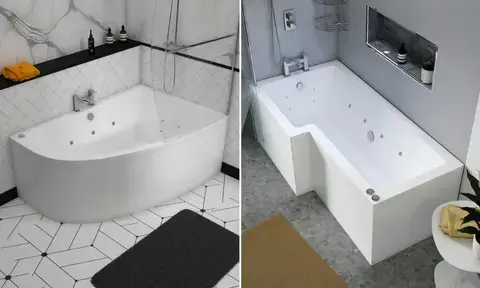
The bath is the central feature of the bathroom.
Choosing the right bath is important, regardless of the size of your bathroom and your visual preferences. The good news is you can find the perfect bath from among the sheer variety of different types of baths available.
You have an assortment of baths to choose from, considering the style, shape, size, and material. And with the latest advances in materials technology, you have a bewildering array of choices: from cast iron to acrylic and stone to copper.
In this in-depth blog post, you will learn about the following:
Navigate to any section of this post by clicking on the links above.
What Different Types of Baths Are There?
Before ordering your new bath, you need to understand the four different types of baths. Only then you’ll know which one will suit your space best.
Shower Baths

A shower bath blends luxury and convenience. A unique feature of this remarkable piece of dual-function – bathtub and shower – design is it does away with the necessity for separate shower and bath units.
Evidently, shower baths are more suitable for smaller bathrooms. Rather than having two separate units, homeowners can combine the functionalities of a bath and shower in a smaller area. This makes the popularity of shower baths on the rise because most bathrooms in modern homes cannot accommodate a separate bath and shower enclosure.
Pros of Shower Baths
- A shower bath is a boon in a small bathroom because it eliminates the need to pick either a bath or a shower. With this space-saving fixture, you can have the best of both worlds.
- A shower bath is a must-have in any home with children as the bath can be filled partially to bathe them first. Later, the shower can be used to rinse away the shampoo and soap suds.
Cons of Shower Baths
- Shower baths are built for both lying down and standing in. But some models may not be comfortable for your back, especially when you intend to enjoy a long soak. This major downside is due to the reduction in their size, the extra taps, and the shower panel.
- A shower bath can be high-maintenance because, with double the use, the cleaning responsibility is also doubled. After every use, you’ll need to rinse both the bath and shower to get rid of soap scum, hair, and debris.
Next, let’s look at the two types of shower baths.
a. L-Shaped Bath
An L-shaped bath provides you an indulgent bathing experience and adds a magnificent touch to your bathroom. This shower bath is available in four sizes: 1500mm, 1670mm, 1700mm, and 1800mm. It’s slightly deeper at the showering end where you stand.
b. P-Shaped Bath
A P-shaped bath has an infill in the extended part that reduces the amount of water required to fill the bath. However, the amount of usable bath space is not reduced. This feature gives you extra space for showering. Both left- or right-handed options are available.
Freestanding Baths

A freestanding bath, as the name suggests, is a bathtub that stands alone and needs space on all sides. This bathroom fixture is a separate piece that not only creates a stunning focal point but also adds a touch of personality.
Due to its larger dimensions, a freestanding bath is more comfortable to bathe in than the other types of baths. While some variants can fit in a small space, most models can be accommodated only in large bathrooms.
Before you buy a freestanding bath, you also need to consider that this unit is heavy. And it gets heavier when it’s filled with water and a person steps in.
Pros of Freestanding Baths
- The high aesthetic quality of a freestanding bath can transform your space into a camera-ready bathroom. Also, the sleek design of a standalone bath is incredibly gorgeous.
- A freestanding bath presents you with considerable flexibility in placement. You can place it anywhere, even directly under a skylight in the centre of the bathroom.
Cons of Freestanding Baths
- Bigger models with a greater depth pose a safety risk for kids. While placing a non-slip mat inside the bath and one on the floor outside can help, the depth of the bath poses a serious risk, especially when filled to the brim.
- The space under a freestanding bath is hard to clean, as water and dirt can get trapped here. As a result, you’ll need to scrub this area more thoroughly.
Next, let’s look at the two types of freestanding baths.
a. Slipper Baths
A slipper bath is elegant and beautiful. The main functionality of this deep-soaking bathtub is that it retains heat and allows you to wallow in warm water for long hours.
The availability of slipper baths in a broad range of styles and designs makes it suitable for almost all bathrooms.
b. Roll Top Baths
A Roll Top Bath makes the ultimate statement in a traditional bath style. If you want to enjoy a truly luxurious bathing experience every day, this bathtub is the right one for you. This freestanding bath is equally available in both traditional as well as contemporary settings.
Corner Baths

Corner baths maximise space in the tiniest of bathrooms and add an element of charm as well. If your bathroom has a tricky layout, this bath will work well. And since you can fit this bath in both left- and right-handed positions, it provides you with supreme convenience.
A corner bath can effortlessly fit in odd and unused corners of your bathroom. This feature can be especially useful in a hexagonal- or irregular-shaped bathroom. Hence, corner baths are best for bathrooms that are tiny or of unconventional shapes. It also makes them an ideal fixture in small bathrooms. Larger models will work well in mid-sized bathrooms.
Pros of Corner Baths
- In terms of ergonomics and compactness, a corner bath is the best. It’s impossible to find a more effective space-management solution. This bath can transform even a tiny bathroom, making it appear more luxurious and spacious.
- A corner bath fits perfectly in any irregular-shaped bathroom. Since this highly functional bath is designed to fit into corners, it frees more floor space.
Cons of Corner Baths
- The major drawback of a corner bath is the limitation in its placement. You can place this bath only in corners. For instance, it will look out of place in the centre of your bathroom.
- A corner bath is more challenging to clean compared to other types of baths, as you’ll need to reach further to clean the corners.
Whirlpool Jacuzzi Baths

A bath fitted with whirlpool jets is known as a whirlpool Jacuzzi bath.
The main feature of a Whirlpool Jacuzzi Bath is that it provides you with luxurious relaxation. This bathtub is all about luxury, comfort, and extravagance.
Since these baths are available in an assortment of sizes, shapes, and configurations, you can easily find one that matches your style, taste, and personality to perfection.
While our three corner whirlpool Jacuzzi bath models can fit in small bathrooms, the larger models are suitable for medium-sized bathrooms. As these baths occupy a larger area, they are ideal for bathrooms with larger dimensions.
Our Ultimate Guide to Whirlpool Baths is a great resource to help you understand everything you need to know about Whirlpool Jacuzzi Baths.
Pros of Whirlpool Jacuzzi Baths
- A whirlpool Jacuzzi bath offers significant health benefits. The positive health trade-offs of water-based treatments – technically termed hydrotherapy – have been valued for thousands of years.
- A whirlpool Jacuzzi bath can add to your home’s resale value, especially if it’s in a premium location.
Cons of Whirlpool Jacuzzi Baths
- A whirlpool Jacuzzi bath is a high-maintenance bath. Other than cleaning the interior of the bath to ensure there are no stray hairs and soap residue, you’ll also need to clean the whirlpool jets after every use.
- A whirlpool Jacuzzi bath is large, bulky, and expensive. It’s difficult to install on your own and needs professional installation.
Bath Types by Size
Large Baths
Large baths present you with a blissful bathing experience, whether you’re considering a double-ended bath for two persons or a single-ended bath just for you.
The main advantage in comparison to a small bath is you are not cramped for space. A large bath provides sufficient space to stretch and relax your body.
If you are over 6ft tall, you’ll need to seriously consider an oversized bath, as it would offer maximum comfort.
Large baths are available in infinite designs from top brands. Cost-effective options that mirror the same quality are also available.
Small Baths
Small baths are suitable for everyone – adults and children alike.
Compared to other baths, a small bath is the easiest to install. You have a lot more freedom, as you don’t need to worry about free space around the bath or proximity to adjacent walls.
Also, elderly people and young children will find it easier to bathe in a small bath. Since elderly people need assistance during bathing, and young children will find it difficult to use a shower, a small bath offers an effective solution.
Bath Types by Material
While many materials are used for manufacturing bathtubs, the following six materials discussed below are the most popular ones:
a. Acrylic Baths
Acrylic is a cost-effective and durable material.
Acrylic sheets are manufactured by combining various materials such as petrochemicals, stabilizers, fillers, resins, and appropriate dyes. These sheets are heated to a high temperature and moulded into the shape of a bath. In the final step, the bath is reinforced with fibreglass.
Baths made of acrylic are one of the most popular in the current marketplace. With proper maintenance, they can easily last for 10 to 15 years.
Acrylic baths are best suited for homeowners who are on a tight budget.
Pros of Acrylic Baths
- Fast installation
- Relatively inexpensive
- Lightweight and durable
- Strong water-resistant surface
- Good heat retention
- Easy to repair
Cons of Acrylic Baths
- The surface is not scratch-resistant
- Sensitive to chemical cleaning agents
- Passable appearance
- Can be squeaky and unstable
b. Enamelled Steel baths
Enamelled steel is a hard-wearing and scratch-resistant material. The enamel coating over the steel material ensures that the bath does not rust.
At 150 to 200 lb (68 to 91 kg), enamelled steel baths are twice as heavy as acrylic baths. Therefore, your bathroom floor needs to be sturdy enough to bear this load.
Since enamelled steel baths are expensive, they are best suited for homeowners for whom budget isn’t a constraint. Remember, their bathroom floor also needs to be sturdy.
Pros of Enamelled Steel Baths
- Highly durable, lasting 25 to 30 years
- Exceptionally stable
- Ultra scratch- and stain-resistant surface
- Not susceptible to cracks
- Easy to clean and maintain
- Resistant to common chemical cleaning agents
Cons of Enamelled Steel Baths
- Installation can be tough and time-consuming
- Extreme care needs to be taken before installation to prevent surface damage
- Susceptible to rusting and chipping if not cared for properly
- Tends to lose heat fast as this material is a good conductor
c. Stone Baths
A stone bath is an install-and-forget fixture that can easily last a lifetime.
Since their aesthetic beauty is guaranteed to last for decades, stone baths are a perfect fit for homeowners keen on making a classy and sophisticated addition to their bathrooms.
Stone baths are prohibitively expensive. Therefore, they are best suited for homeowners who want to make a style statement and have a deep pocket.
Pros of Stone Baths
- High-end and luxurious appearance
- Timeless design
- Resistant to chipping
- Durable and highly scratch-resistant
- Conserves more heat
- Highly stable
Cons of Stone Baths
- Heavy price tag
- Ultra heavyweight (some models weigh 3,000 lb), so the floor will need reinforcement
- Difficult to install beyond the ground floor level
- High-maintenance fixture
d. Carronite Baths
Carronite is a patented manufacturing process from Carron Bathrooms. This triple-layer reinforcement process is the reason that all Carronite baths come with a 30-year guarantee.
The main feature of this bath is the Carronite Baseboard that delivers additional stability. The specially formulated finish also increases heat retention.
Carronite baths are the perfect choice for homeowners who want to buy an extra-strong bath that will last for decades at a competitive price.
If you need help with deciding what to look for when buying Carronite baths, give our detailed Carronite Baths Guide a read.
Pros of Carronite Baths
- Easy installation
- Extended 30-year guarantee
- Superior stability
- Strong water-resistant surface
- Excellent heat retention
- Unparalleled strength
Cons of Carronite Baths
- None, as the triple-layer reinforcement process effectively addresses all the drawbacks of acrylic baths.
e. Steel Baths and Cast Iron Bathtubs
While cast iron bathtubs are quite heavy, steel baths are four to five times lighter in weight. Other than the weight factor, there is no major difference between them.
Cast iron is a highly durable material. Also, the thick enamel coating on its surface is resistant to most chemicals, scratching, and chipping.
Steel baths and cast iron bathtubs are best suited for homeowners looking to personalise their dream bathrooms.
Pros of Steel Baths and Cast Iron Bathtubs
- Highly durable, lasting 25 to 30 years
- Exceptionally stable
- Ultra scratch-resistant surface
- Crack-resistant
- Generous bathing space
- Impact- and abrasion-resistant
Cons of Steel Baths and Cast Iron Bathtubs
- Installation of cast iron bathtubs can be tough
- Difficult to fix plumbing issues if the heavy cast iron bathtub needs to be moved
- Vulnerable to rust if not cared for properly
- The hard metal surface is not comfortable to sit in for long periods
f. Copper Baths
Pure copper is super strong and almost indestructible. A copper bath is made by heating sheets of copper and hammering them into shape.
Maintenance is easy as you don’t need to scrub or polish a copper bath. You’ll only need to rinse the bath with water and wipe the surface dry to prevent mineral deposit build-up. Avoid using abrasives as they can damage the finish.
The beauty of a pure copper bath enhances greatly with age. Since these baths are guaranteed to age gracefully, they would be the right choice for homeowners who love sophistication and luxury.
Pros of Copper Baths
- Durable and withstands rust
- Has several health benefits as it has antimicrobial properties
- Naturally resistant to scratching and chipping
- Maintenance is very simple
- Copper can heal itself of small scratches
- Retains heat longer
Cons of Copper Baths
- Installation can be tough as the bath is heavy
- Fixing plumbing problems is not easy if the heavy bath has to be moved
- High price tag
Conclusion
The bathtub is the focal point in your bathroom. Hence, it’s critical to invest in a good quality bath as it can easily outlast many future renovation projects.
It makes sense to buy a bath that’s beautiful as well as useful. And since a bathtub is a big investment both in terms of space as well as money, you need to consider the fact that a freestanding bath will occupy more space and cost you more than a built-in one.
Shop for Baths
Consider the factors discussed here before buying a bath. At Bathroom City, you will find a wide range of bath designs. Starting from the basic or traditional designs, you can explore the premium luxurious freestanding baths at our store and find your perfect bath.
Other related articles that might also interest you: